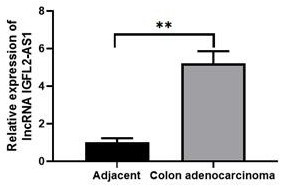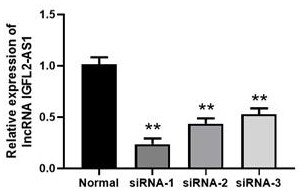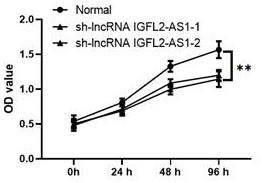Application of lncRNA IGFL2-AS1 as a diagnostic marker for colon cancer
A technique for colon cancer, biological samples, applied in the field of tumor molecular biology
- Summary
- Abstract
- Description
- Claims
- Application Information
AI Technical Summary
Problems solved by technology
Method used
Image
Examples
Embodiment 1
[0031] Example 1: Real-time PCR detection of lncRNA IGFL2-AS1
[0032] Extract total RNA:
[0033] From colon cancer tissue samples and adjacent tissue samples, add 1 mL After the Reagent was placed at room temperature (15-30°C), the nucleoprotein complexes were completely separated. After 5 min, add 0.2 mL of chloroform, cover the tube, shake vigorously by hand for 15 s, and leave at room temperature for 2-3 min. Centrifuge at 12 000 g for 15 min at 2-8 °C, and transfer the upper colorless aqueous phase to another 1.5 mL Eppendorf tube. Add 0.5 mL of isopropanol and leave at room temperature for 10 min. Centrifuge at 12 000 g for 10 min at 2-8 °C and discard the supernatant. The RNA pellet was washed with 1 mL of 75% ethanol and mixed with a vortex mixer. Centrifuge at 7500g for 5 min at 2-8°C and discard the supernatant. Use RNase-free ddH after air drying for 5-10 min 2 O dissolves RNA, blows and sucks repeatedly with a micropipette and incubates at 55-60 °C for 10 ...
Embodiment example 2
[0044] Example 2: Knockdown of lncRNA IGFL2-AS1 in cancer cells
[0045] The SW620 cell line was selected for the knockdown experiment of lncRNA IGFL2-AS1, and the related gene expression and cell migration ability after knockdown were detected.
[0046] Knockdown of lncRNA IGFL2-AS1:
[0047] The knockdown of lncRNA IGFL2-AS1 was achieved by siRNA. The specific method was as follows: cells were plated on a six-well plate, and when the plate was 50% full the next day, starve with Opti-MEM for 30 minutes;
[0048] Dissolve 2.5 nmol siRNA / NC with 125 μL of DEPC water, and the amount of each well is 10 μL. Take two tubes labeled A and B, add 100 μL Opti-MEM to each tube; add 10 μL lipofectamine 3000 to tube A, add 10 μL siRNA or NC to tube B, mix well and let stand at room temperature for 5 min. The two tubes of AB were fully mixed, and added to the six-well plate for 15 min, and transfected for 6-8 h.
[0049] The siRNA used in the research of the present invention, the seque...
Embodiment example 3
[0057] Implementation Case 3: CCK-8 Experiment
[0058] Take 1×10 5 SW620 cells were seeded in a 12-well plate at 37°C with 5% CO. 2 Culture, when the cells grow to 70% confluence the next day, remove the original medium, add cells, trypsinize after 24 h, and inoculate 3 000 cells / well in a 96-well plate, with 5 duplicate wells in each group . After culturing for 1-7 days, 10 μl of CCK-8 was added to each well, and the culture was continued for 1 h. The blank well was used to adjust zero, the wavelength was 450 nm, and the OD value was detected by an automatic enzyme label reader.
[0059] The result is as image 3 shown, the cells transfected with siRNA had reduced proliferative capacity compared to tumor cells that were not knocked down.
PUM
 Login to View More
Login to View More Abstract
Description
Claims
Application Information
 Login to View More
Login to View More - R&D
- Intellectual Property
- Life Sciences
- Materials
- Tech Scout
- Unparalleled Data Quality
- Higher Quality Content
- 60% Fewer Hallucinations
Browse by: Latest US Patents, China's latest patents, Technical Efficacy Thesaurus, Application Domain, Technology Topic, Popular Technical Reports.
© 2025 PatSnap. All rights reserved.Legal|Privacy policy|Modern Slavery Act Transparency Statement|Sitemap|About US| Contact US: help@patsnap.com



